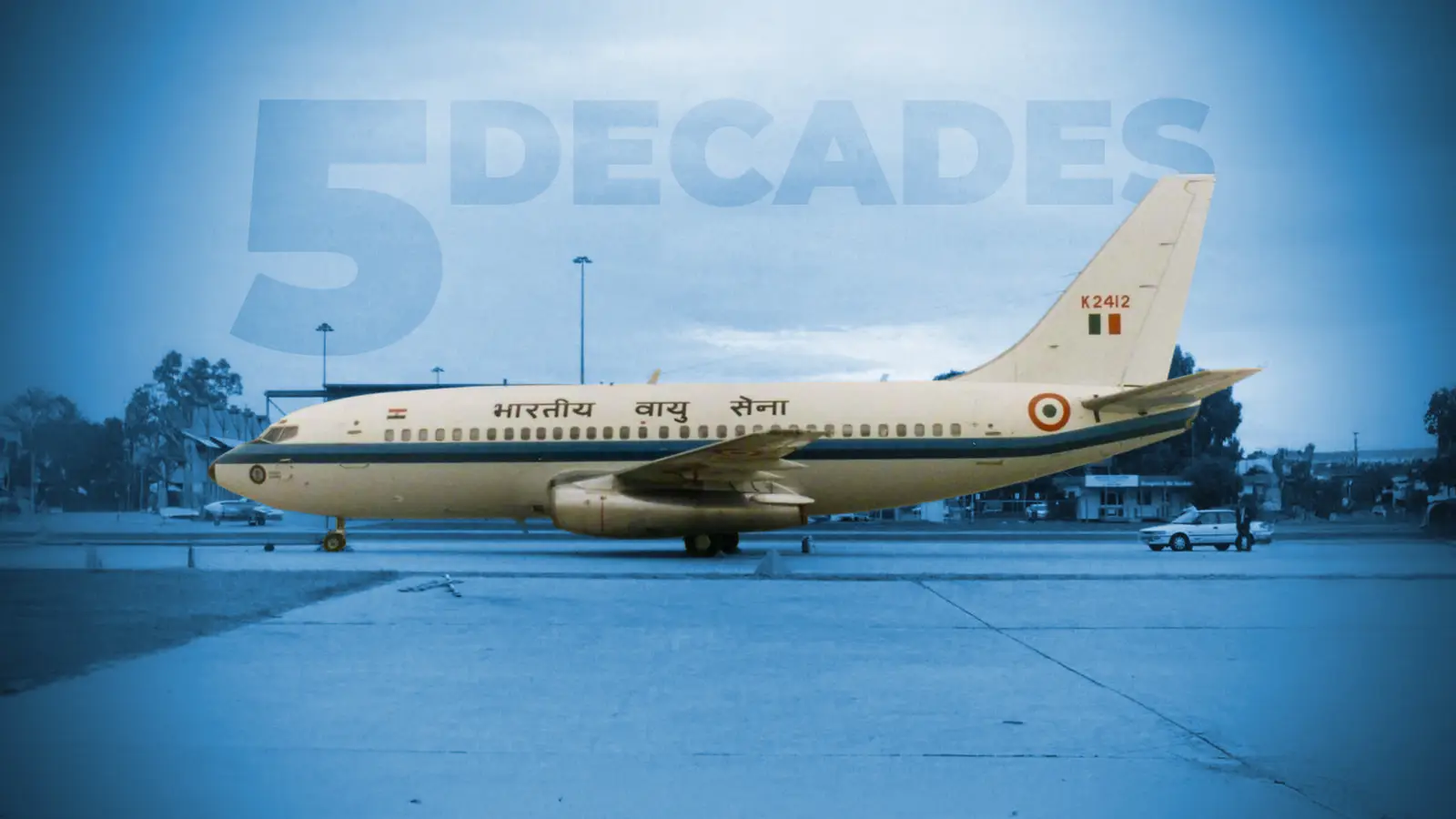
When Boeing first introduced the Boeing 737-200 in the late 1960s, the aviation world had no idea just how enduring this jet would prove to be. Designed as a short-haul workhorse, the aircraft became a backbone for airlines worldwide, ferrying millions of passengers on routes of all sizes. Its rugged design and adaptability quickly earned it a reputation for being a reliable and versatile aircraft.
Today, more than half a century later, a handful of these “Baby Boeings” are still in the skies, often in some of the world’s most challenging and unique operating environments. While most have long since been retired to museums or scrapyards, these survivors continue to prove that with the right care (and sometimes a bit of creativity), the 737-200 is almost impossible to ground.
The World’s Oldest: India’s 54-Year-Old 737-200
The title of the “oldest active Boeing 737-200” belongs to a true survivor: K3187 of the Indian Air Force. Delivered in 1971, this aircraft has been flying for an astonishing 54 years. Originally designed for civilian airline duty, this particular 737 has spent much of its life in military service, transporting personnel and government officials across India’s vast and varied geography.
Unlike many of its siblings that retired to scrapyards or museums decades ago, K3187 has remained in frontline service thanks to the Air Force’s rigorous maintenance schedule and strategic need for reliable mid-size transports. Its rugged JT8D engines and proven systems have helped it remain a dependable workhorse, even in a world dominated by more modern narrowbodies. For the Indian Air Force, the aircraft represents a blend of utility and legacy, a reminder that newer doesn’t always mean better, especially when the mission requires tried-and-true reliability.
Remarkably, K3187 isn’t alone. The Indian Air Force still fields three other 737-200s: K2412, K2413, and K2414 (delivered in the early 1980s), all of which remain active today. While younger than K3187, these aircraft are themselves over 42 years old, making the IAF one of the largest and most enduring operators of the type.
Latin America’s Stalwarts: Venezuela, Ecuador & Honduras Keep Them Alive
Latin America has long been a stronghold for older jets, and the Boeing 737-200 remains a familiar sight in the region. In Venezuela, Venezolana, Estelar, and Avior keep the type in the air. Venezolana’s YV3471, delivered in 1978, is now 47 years old and among the oldest passenger 737s still flying. Alongside it, Estelars’ YV2792 and Aviors’ YV2794, both early-1980s builds, continue to operate, giving local travelers a rare chance to fly on a machine that feels straight out of aviation’s golden age.
The Fuerza Aérea Ecuatoriana also keeps the legacy alive with FAE-630, a 1980-built 737-200 used for government and transport duties. Ecuador’s high-altitude airports and rugged geography are perfectly matched to the aircraft’s durability, proving that reliability often outweighs modernity in challenging operating environments.
In Central America, Honduras-based Aviatsa operates HR-MRZ, a 1983 airframe that continues in active service. While airlines across the world retired the 737–200 decades ago, these operators have found ways to keep them useful, often through careful maintenance and repurposing. Across Latin America, the 737-200 isn’t just surviving, it’s thriving as a symbol of endurance and adaptability.
Military Lifelines In Indonesia
Few countries rely on the Boeing 737-200 quite like Indonesia. The Tentara Nasional Indonesia Angkatan Udara (TNI-AU), or Indonesian Air Force, still operates multiple examples, many of them delivered in the early 1980s. Aircraft such as AI-7301, AI-7302, AI-7303, and AI-7304, all more than 42 years old, remain in active service, making Indonesia one of the largest military operators of the type anywhere in the world.
For Indonesia, a sprawling archipelago of over 17,000 islands, the 737–200 offers an ideal balance of capacity, range, and ruggedness. Its ability to handle short or less-developed runways makes it invaluable for moving personnel and supplies between bases scattered across the country. The fleet’s longevity reflects both the military’s trust in the type and the ongoing need for reliable, mid-sized transport in a nation where logistics are always a challenge.
Unlike their counterparts in commercial service, Indonesia’s military 737-200s aren’t constrained by strict fuel-efficiency economics. Instead, their continued use highlights the type’s adaptability and robustness under demanding conditions. Decades after first delivery, these aircraft remain frontline assets, proving that the “Baby Boeing” still has a crucial role to play in the world’s largest archipelago nation.
Canada’s Cold Warrior: Nolinors’ Gravel-Kit Workhorse
In Canada, the Boeing 737-200 has carved out a second life as a specialist aircraft for some of the world’s most demanding routes. Nolinor Aviation, based in Quebec, operates C-FTWW, a 1981-built airframe that is still going strong after more than 44 years of service. What makes this aircraft unique is its gravel kit, a modification that allows it to land on unpaved and remote runways where modern jets cannot operate.
These features make the 737-200 a perfect fit for Canada’s Arctic and northern regions, where communities and mining operations often rely on rough airstrips rather than paved airports. Nolinors’ aircraft carry everything from passengers to heavy equipment, serving as lifelines to areas inaccessible by road for much of the year. While larger airlines phased the type out long ago, Nolinor has embraced its niche role as a specialist operator of one of aviation’s most enduring designs.
For travelers and enthusiasts, flying on one of these missions offers a rare chance to experience the classic 737-200 in its element. With its gravel kit, rugged engines, and ability to withstand extreme cold, Nolinors’ fleet proves that the “Baby Boeing” still has tricks up its sleeve. In an age of advanced technology and composite airframes, this 1981 jet continues to thrive in one of the harshest environments on Earth.
Still Serving In Uniform: Military Operators Worldwide
Beyond India and Indonesia, several other air forces continue to rely on the Boeing 737-200 for transport and government duties. The Fuerza Aérea Mexicana operates FAM-3520, a 1984-delivered example that remains active after more than four decades. In South America, the Fuerza Aérea Ecuatoriana still employs its veteran FAE-630, while the Fuerza Aérea Venezolana has also turned to the type in past years. These aircraft are not just relics; they are active participants in military logistics and VIP transport.
What makes the 737-200 valuable to air forces is its flexibility. The jet can be configured for passengers, cargo, or a mix of both, depending on mission requirements. Its relatively small size compared to widebodies makes it economical to operate, yet it offers more range and comfort than turboprops. For countries that do not require or cannot justify larger military transport, the 737-200 remains a practical solution.
Top ten oldest 737-200s in active service, data from ch-aviation.
Despite their age, these military 737s often receive careful upkeep and, in some cases, upgrades to avionics and interiors. Unlike airlines, which retire aircraft once they become uneconomical, militaries can keep them flying for decades if they meet operational needs. This ensures that even in 2025, the Boeing 737-200 continues to wear military colors proudly, serving as a testament to the type’s longevity and adaptability.
The Baby Boeing’s Remarkable Staying Power
More than half a century after its debut with United Airlines in 1968, the Boeing 737-200 continues to defy retirement predictions. From India’s record-setting K3187, to Nolinors’ gravel-kit operations in Canada to military fleets in Indonesia and Mexico, the type has proven that durability and versatility can outlast generations of newer designs. While most of the world has moved on to fuel-efficient 737NGs and MAX jets, these surviving classics highlight a different story: one of endurance and adaptability in specialized roles.
What unites the operators still flying the 737-200 is not nostalgia but necessity. Whether it’s navigating the tundra of northern Canada, hopping between remote islands in Indonesia, or fulfilling military transport duties in Latin America, the aircraft continues to do jobs that newer jets aren’t always suited for. Its relatively simple systems, proven engines, and rugged construction have made it a perfect fit for environments where reliability matters more than efficiency.
For aviation enthusiasts, the continued presence of the 737-200 in the skies is a gift, a rare chance to experience a piece of living history in action. Each flight is not just a trip, but a connection to the earliest days of Boeing’s 737 program. And as long as operators find value in its unique capabilities, the “Baby Boeing” will continue to remind the world that sometimes, the oldest planes can still be the most dependable.



